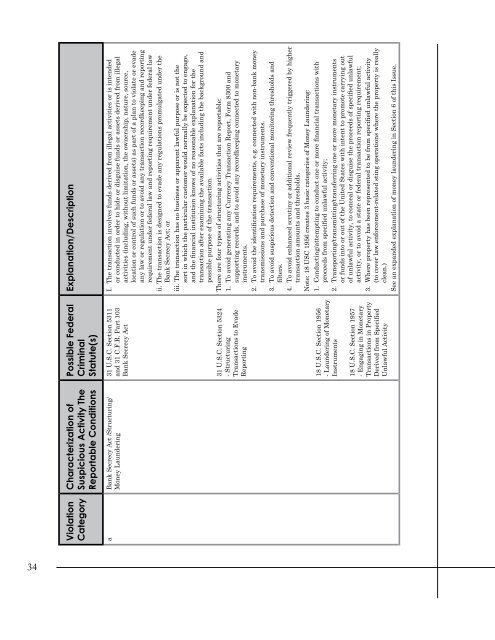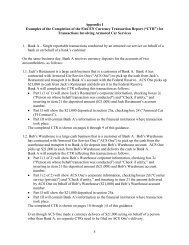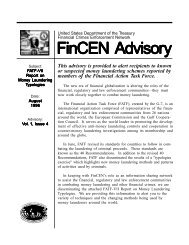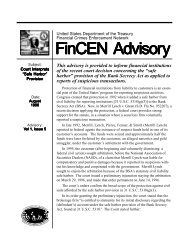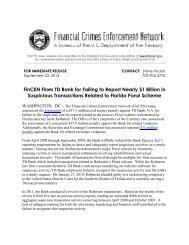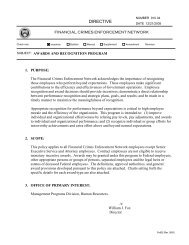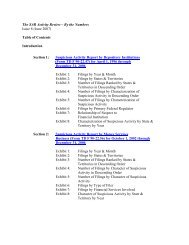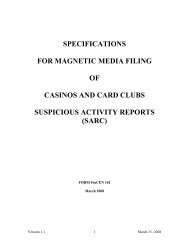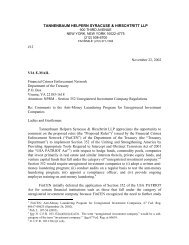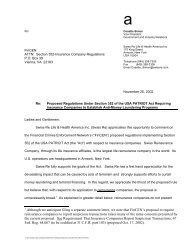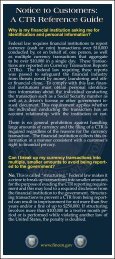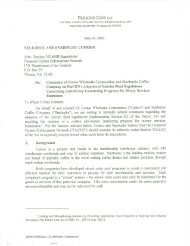The SAR Activity Review Issue 12 - FinCEN
The SAR Activity Review Issue 12 - FinCEN
The SAR Activity Review Issue 12 - FinCEN
You also want an ePaper? Increase the reach of your titles
YUMPU automatically turns print PDFs into web optimized ePapers that Google loves.
Explanation/Description<br />
Possible Federal<br />
Criminal<br />
Statute(s)<br />
Characterization of<br />
Suspicious <strong>Activity</strong> <strong>The</strong><br />
Reportable Conditions<br />
Violation<br />
Category<br />
I. <strong>The</strong> transaction involves funds derived from illegal activities or is intended<br />
or conducted in order to hide or disguise funds or assets derived from illegal<br />
activities (including, without limitation, the ownership, nature, source,<br />
location or control of such funds or assets) as part of a plan to violate or evade<br />
any law or regulation or to avoid any transaction recordkeeping and reporting<br />
requirement under federal law and reporting requirement under federal law<br />
31 U.S.C. Section 5311<br />
and 31 C.F.R. Part 103<br />
Bank Secrecy Act<br />
a Bank Secrecy Act /Structuring/<br />
Money Laundering<br />
ii. <strong>The</strong> transaction is designed to evade any regulations promulgated under the<br />
Bank Secrecy Act; or<br />
iii. <strong>The</strong> transaction has no business or apparent lawful purpose or is not the<br />
sort in which the particular customer would normally be expected to engage,<br />
and the financial institution knows of no reasonable explanation for the<br />
transaction after examining the available facts including the background and<br />
possible purpose of the transaction.<br />
<strong>The</strong>re are four types of structuring activities that are reportable:<br />
1. To avoid generating any Currency Transaction Report, Form 8300 and<br />
supporting records, and to avoid any recordkeeping connected to monetary<br />
instruments.<br />
2. To avoid the identification requirements, e.g. connected with non-bank money<br />
transmissions and purchase of monetary instruments.<br />
31 U.S.C. Section 5324<br />
- Structuring<br />
Transactions to Evade<br />
Reporting<br />
3. To avoid suspicious detection and conventional monitoring thresholds and<br />
filters.<br />
4. To avoid enhanced scrutiny or additional review frequently triggered by higher<br />
transaction amounts and thresholds.<br />
Note: 18 USC 1956 creates 3 basic categories of Money Laundering:<br />
1. Conducting/attempting to conduct one or more financial transactions with<br />
proceeds from specified unlawful activity;<br />
18 U.S.C. Section 1956<br />
- Laundering of Monetary<br />
Instruments<br />
2. Transporting/transmitting/transferring one or more monetary instruments<br />
or funds into or out of the United States with intent to promote carrying out<br />
of unlawful activity, to conceal or disguise the proceeds of specified unlawful<br />
activity, or to avoid a state or federal transaction reporting requirement;<br />
3. Where property has been represented to be from specified unlawful activity<br />
(to cover law enforcement-related sting operations where the property is really<br />
clean.)<br />
See an expanded explanation of money laundering in Section 6 of this <strong>Issue</strong>.<br />
18 U.S.C. Section 1957<br />
- Engaging in Monetary<br />
Transactions in Property<br />
Derived from Specified<br />
Unlawful <strong>Activity</strong>


